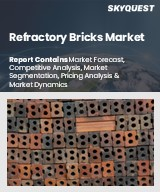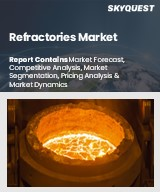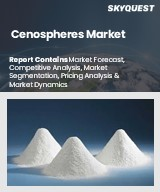
|
시장보고서
상품코드
1813884
내화물 시장 규모, 점유율, 동향 분석 보고서 : 최종 용도별, 지역별, 부문별 예측(2025-2033년)Refractories Market Size, Share & Trends Analysis Report By End Use (Iron & Steel, Cement & Lime, Glass & Ceramics, Non-Ferrous Metals), By Region (North America, Europe, Asia Pacific), And Segment Forecasts, 2025 - 2033 |
||||||
내화물 시장 요약
세계 내화물 시장 규모는 2024년 453억 6,000만 달러로 추정되며, 2025년부터 2033년까지 CAGR 9.1%로 2033년에는 959억 6,000만 달러에 달할 것으로 예상됩니다.
염기성 산소로(BOF), 전기 아크로(EAF), 유도로(IF)에 의한 조강 생산에서는 극한의 온도와 화학적 마모에 견디기 위해 대량의 정형 내화물과 비정형 내화물이 필요합니다.
인도, 중국, 베트남과 같은 국가들이 인프라 구축 및 건설 프로젝트를 강화함에 따라 철강 수요, 나아가 내화물의 수요도 지속적으로 증가하고 있습니다. 또한, 유럽과 아시아에서 그린 스틸에 대한 노력은 새로운 EAF 설비에 대한 투자를 촉진하여 내화물 소비를 더욱 강화하고 있습니다. 시멘트 가마에서는 1400℃ 이상의 온도에서 가동되기 때문에 내화 라이닝의 지속적인 교체가 요구됩니다. 아시아태평양과 아프리카의 급속한 도시화와 인구 증가는 도로, 교량, 주택, 상업용 건물 건설에 박차를 가하고 시멘트 생산량 증가로 이어집니다. 또한, 인도, 인도네시아, 나이지리아 등 주요 시멘트 업체들의 생산능력 확대 계획이 기초 내화물 및 비기초 내화물의 수요를 증가시키고 있습니다.
비철금속 산업의 수요 증가도 시장 성장에 기여하고 있습니다. 구리, 알루미늄, 아연, 니켈 제련소에서는 화학적으로 침식성이 높은 슬래그와 높은 열 부하를 처리하기 위해 특수 내화 라이닝이 필요합니다. 에너지 전환에 대한 노력이 가속화됨에 따라 전기자동차 배터리, 풍력 터빈, 태양광 패널에서 이들 금속에 대한 수요가 증가하고 있습니다. 이 때문에 라틴아메리카, 아프리카, 호주 등 지역의 기업들은 제련 시설의 확장 및 개선에 투자하여 내화물의 안정적인 사용을 촉진하고 있습니다.
목차
제1장 조사 방법과 범위
제2장 주요 요약
제3장 시장 변수, 동향, 범위
- 시장 전망
- 업계 밸류체인 분석
- 판매 채널 분석
- 테크놀러지 개요
- 규제 프레임워크
- 시장 역학
- 시장 성장 촉진요인 분석
- 시장 성장 억제요인 분석
- 업계 동향
- ESG 분석
- 경제 동향
- Porter's Five Forces 분석
- 공급 기업의 교섭력
- 구매자의 교섭력
- 대체의 위협
- 신규 참여업체의 위협
- 경쟁 기업 간의 경쟁 관계
- PESTLE 분석
- 정치적
- 경제
- 사회 상황
- 테크놀러지
- 환경
- 법률상
제4장 내화물 시장 : 최종 용도 추정·동향 분석
- 내화물 시장 : 최종 용도 변동 분석, 2024년 및 2033년
- 철강
- 시멘트와 석회
- 유리와 세라믹
- 비철금속
- 기타
제5장 내화물 시장 : 지역 추정·동향 분석
- 지역 분석, 2024년과 2033년
- 북미
- 최종 용도별, 2021-2033년
- 미국
- 캐나다
- 멕시코
- 유럽
- 최종 용도별, 2021-2033년
- 독일
- 영국
- 러시아
- 프랑스
- 아시아태평양
- 최종 용도별, 2021-2033년
- 중국
- 인도
- 일본
- 한국
- 라틴아메리카
- 최종 용도별, 2021-2033년
- 브라질
- 중동 및 아프리카
- 최종 용도별, 2021-2033년
- 남아프리카공화국
제6장 경쟁 구도
- 주요 시장 진입 기업의 최근 동향과 영향 분석
- 기업 분류
- 히트맵 분석
- 벤더 상황
- 판매대리점 리스트
- List of Prospective End-Users
- Strategy Initiatives
- 기업 개요/상장 기업
- Chosun Refractories Co., Ltd.
- CoorsTek Inc.
- HarbisonWalker International
- Imerys
- Krosaki Harima
- Morgan Advanced Materials
- RHI Magnesita
- Saint-Gobain SEFPRO
- Shinagawa Refractories
- Vesuvius
Refractories Market Summary
The global refractories market size was estimated at USD 45.36 billion in 2024 and is projected to reach USD 95.96 billion by 2033, at a CAGR of 9.1% from 2025 to 2033. Crude steel manufacturing through basic oxygen furnaces (BOF), electric arc furnaces (EAF), and induction furnaces (IF) requires high volumes of shaped and unshaped refractories to withstand extreme temperatures and chemical wear.
As countries like India, China, and Vietnam ramp up infrastructure and construction projects, steel demand and, thus, refractories continue to rise. Additionally, green steel initiatives in Europe and Asia encourage investments in new EAF setups, further strengthening refractory consumption. Cement kilns operate at temperatures exceeding 1400°C, demanding consistent refractory lining replacement. Rapid urbanization and population growth in the Asia Pacific and Africa are fueling the construction of roads, bridges, residential, and commercial buildings, which translates to higher cement output. Moreover, capacity expansion plans by major cement producers in countries like India, Indonesia, and Nigeria are boosting demand for basic and non-basic refractories.
Rising demand from the non-ferrous metals industry is also contributing to market growth. Copper, aluminum, zinc, and nickel smelters require specialized refractory linings to handle chemically aggressive slags and high thermal loads. As energy transition efforts accelerate, demand for these metals in EV batteries, wind turbines, and solar panels increases. This is pushing companies in regions like Latin America, Africa, and Australia to invest in expanding and upgrading their smelting facilities, driving consistent refractory usage.
Global Refractories Market Report Segmentation
This report forecasts revenue and volume growth at global, regional, and country levels and provides an analysis of the latest industry trends in each of the sub-segments from 2021 to 2033. For this study, Grand View Research has segmented the global refractories market report based on the end use and region.
- End Use Outlook (Volume, Kilotons; Revenue, USD Million, 2021 - 2033)
- Iron & Steel
- Cement & Lime
- Glass & Ceramics
- Non-Ferrous Metals
- Others
- Regional Outlook (Volume, Kilotons; Revenue, USD Million, 2021 - 2033)
- North America
- U.S.
- Canada
- Mexico
- Europe
- Germany
- UK
- Russia
- France
- Asia Pacific
- China
- India
- Japan
- South Korea
- Latin America
- Brazil
- Middle East & Africa
- Saudi Africa
Table of Contents
Chapter 1. Methodology and Scope
- 1.1. Market Segmentation & Scope
- 1.2. Market Definition
- 1.3. Information Procurement
- 1.3.1. Information Analysis
- 1.3.2. Data Analysis Models
- 1.3.3. Market Formulation & Data Visualization
- 1.3.4. Data Validation & Publishing
- 1.4. Research Scope and Assumptions
- 1.4.1. List of Data Sources
Chapter 2. Executive Summary
- 2.1. Market Outlook
- 2.2. Segmental Outlook
- 2.3. Competitive Outlook
Chapter 3. Market Variables, Trends, and Scope
- 3.1. Market Outlook
- 3.2. Industry Value Chain Analysis
- 3.2.1. Sales Channel Analysis
- 3.3. Technology Overview
- 3.4. Regulatory Framework
- 3.5. Market Dynamics
- 3.5.1. Market Driver Analysis
- 3.5.2. Market Restraint Analysis
- 3.6. Industry Trends
- 3.6.1. ESG Analysis
- 3.6.2. Economic Trends
- 3.7. Porter's Five Forces Analysis
- 3.7.1. Bargaining Power of Suppliers
- 3.7.2. Bargaining Power of Buyers
- 3.7.3. Threat of Substitution
- 3.7.4. Threat of New Entrants
- 3.7.5. Competitive Rivalry
- 3.8. PESTLE Analysis
- 3.8.1. Political
- 3.8.2. Economic
- 3.8.3. Social Landscape
- 3.8.4. Technology
- 3.8.5. Environmental
- 3.8.6. Legal
Chapter 4. Refractories Market: End Use Estimates & Trend Analysis
- 4.1. Refractories Market: End Use Movement Analysis, 2024 & 2033
- 4.2. Iron & Steel
- 4.2.1. Market estimates and forecasts, 2021 - 2033 (USD Million) (Kilotons)
- 4.3. Cement & Lime
- 4.3.1. Market estimates and forecasts, 2021 - 2033 (USD Million) (Kilotons)
- 4.4. Glass & Ceramics
- 4.4.1. Market estimates and forecasts, 2021 - 2033 (USD Million) (Kilotons)
- 4.5. Non-Ferrous Metals
- 4.5.1. Market estimates and forecasts, 2021 - 2033 (USD Million) (Kilotons)
- 4.6. Others
- 4.6.1. Market estimates and forecasts, 2021 - 2033 (USD Million) (Kilotons)
Chapter 5. Refractories Market: Regional Estimates & Trend Analysis
- 5.1. Regional Analysis, 2024 & 2033
- 5.2. North America
- 5.2.1. Market estimates and forecasts, 2021 - 2033 (USD Million) (Kilotons)
- 5.2.2. Market estimates and forecasts, by end use, 2021 - 2033 (USD Million) (Kilotons)
- 5.2.3. U.S.
- 5.2.3.1. Market estimates and forecasts, 2021 - 2033 (USD Million) (Kilotons)
- 5.2.3.2. Market estimates and forecasts, by end use, 2021 - 2033 (USD Million) (Kilotons)
- 5.2.4. Canada
- 5.2.4.1. Market estimates and forecasts, 2021 - 2033 (USD Million) (Kilotons)
- 5.2.4.2. Market estimates and forecasts, by end use, 2021 - 2033 (USD Million) (Kilotons)
- 5.2.5. Mexico
- 5.2.5.1. Market estimates and forecasts, 2021 - 2033 (USD Million) (Kilotons)
- 5.2.5.2. Market estimates and forecasts, by end use, 2021 - 2033 (USD Million) (Kilotons)
- 5.3. Europe
- 5.3.1. Market estimates and forecasts, 2021 - 2033 (USD Million) (Kilotons)
- 5.3.2. Market estimates and forecasts, by end use, 2021 - 2033 (USD Million) (Kilotons)
- 5.3.3. Germany
- 5.3.3.1. Market estimates and forecasts, 2021 - 2033 (USD Million) (Kilotons)
- 5.3.3.2. Market estimates and forecasts, by end use, 2021 - 2033 (USD Million) (Kilotons)
- 5.3.4. UK
- 5.3.4.1. Market estimates and forecasts, 2021 - 2033 (USD Million) (Kilotons)
- 5.3.4.2. Market estimates and forecasts, by end use, 2021 - 2033 (USD Million) (Kilotons)
- 5.3.5. Russia
- 5.3.5.1. Market estimates and forecasts, 2021 - 2033 (USD Million) (Kilotons)
- 5.3.5.2. Market estimates and forecasts, by end use, 2021 - 2033 (USD Million) (Kilotons)
- 5.3.6. France
- 5.3.6.1. Market estimates and forecasts, 2021 - 2033 (USD Million) (Kilotons)
- 5.3.6.2. Market estimates and forecasts, by end use, 2021 - 2033 (USD Million) (Kilotons)
- 5.4. Asia Pacific
- 5.4.1. Market estimates and forecasts, 2021 - 2033 (USD Million) (Kilotons)
- 5.4.2. Market estimates and forecasts, by end use, 2021 - 2033 (USD Million) (Kilotons)
- 5.4.3. China
- 5.4.3.1. Market estimates and forecasts, 2021 - 2033 (USD Million) (Kilotons)
- 5.4.3.2. Market estimates and forecasts, by end use, 2021 - 2033 (USD Million) (Kilotons)
- 5.4.4. India
- 5.4.4.1. Market estimates and forecasts, 2021 - 2033 (USD Million) (Kilotons)
- 5.4.4.2. Market estimates and forecasts, by end use, 2021 - 2033 (USD Million) (Kilotons)
- 5.4.5. Japan
- 5.4.5.1. Market estimates and forecasts, 2021 - 2033 (USD Million) (Kilotons)
- 5.4.5.2. Market estimates and forecasts, by end use, 2021 - 2033 (USD Million) (Kilotons)
- 5.4.6. South Korea
- 5.4.6.1. Market estimates and forecasts, 2021 - 2033 (USD Million) (Kilotons)
- 5.4.6.2. Market estimates and forecasts, by end use, 2021 - 2033 (USD Million) (Kilotons)
- 5.5. Latin America
- 5.5.1. Market estimates and forecasts, 2021 - 2033 (USD Million) (Kilotons)
- 5.5.2. Market estimates and forecasts, by end use, 2021 - 2033 (USD Million) (Kilotons)
- 5.5.3. Brazil
- 5.5.3.1. Market estimates and forecasts, 2021 - 2033 (USD Million) (Kilotons)
- 5.5.3.2. Market estimates and forecasts, by end use, 2021 - 2033 (USD Million) (Kilotons)
- 5.6. Middle East & Africa
- 5.6.1. Market estimates and forecasts, 2021 - 2033 (USD Million) (Kilotons)
- 5.6.2. Market estimates and forecasts, by end use, 2021 - 2033 (USD Million) (Kilotons)
- 5.6.3. South Africa
- 5.6.3.1. Market estimates and forecasts, 2021 - 2033 (USD Million) (Kilotons)
- 5.6.3.2. Market estimates and forecasts, by end use, 2021 - 2033 (USD Million) (Kilotons)
Chapter 6. Competitive Landscape
- 6.1. Recent Developments & Impact Analysis, By Key Market Participants
- 6.2. Company Categorization
- 6.3. Heat Map Analysis
- 6.4. Vendor Landscape
- 6.4.1. List of distributors
- 6.5. List of Prospective End-Users
- 6.6. Strategy Initiatives
- 6.7. Company Profiles/Listing
- 6.7.1. Chosun Refractories Co., Ltd.
- 6.7.1.1. Company Overview
- 6.7.1.2. Financial Performance
- 6.7.1.3. Product Benchmarking
- 6.7.2. CoorsTek Inc.
- 6.7.2.1. Company Overview
- 6.7.2.2. Financial Performance
- 6.7.2.3. Product Benchmarking
- 6.7.3. HarbisonWalker International
- 6.7.3.1. Company Overview
- 6.7.3.2. Financial Performance
- 6.7.3.3. Product Benchmarking
- 6.7.4. Imerys
- 6.7.4.1. Company Overview
- 6.7.4.2. Financial Performance
- 6.7.4.3. Product Benchmarking
- 6.7.5. Krosaki Harima
- 6.7.5.1. Company Overview
- 6.7.5.2. Financial Performance
- 6.7.5.3. Product Benchmarking
- 6.7.6. Morgan Advanced Materials
- 6.7.6.1. Company Overview
- 6.7.6.2. Financial Performance
- 6.7.6.3. Product Benchmarking
- 6.7.7. RHI Magnesita
- 6.7.7.1. Company Overview
- 6.7.7.2. Financial Performance
- 6.7.7.3. Product Benchmarking
- 6.7.8. Saint-Gobain SEFPRO
- 6.7.8.1. Company Overview
- 6.7.8.2. Financial Performance
- 6.7.8.3. Product Benchmarking
- 6.7.9. Shinagawa Refractories
- 6.7.9.1. Company Overview
- 6.7.9.2. Financial Performance
- 6.7.9.3. Product Benchmarking
- 6.7.10. Vesuvius
- 6.7.10.1. Company Overview
- 6.7.10.2. Financial Performance
- 6.7.10.3. Product Benchmarking
- 6.7.1. Chosun Refractories Co., Ltd.
(주말 및 공휴일 제외)


















